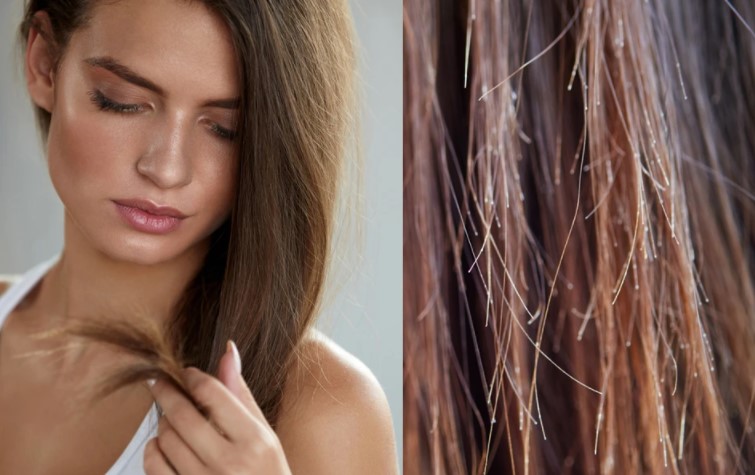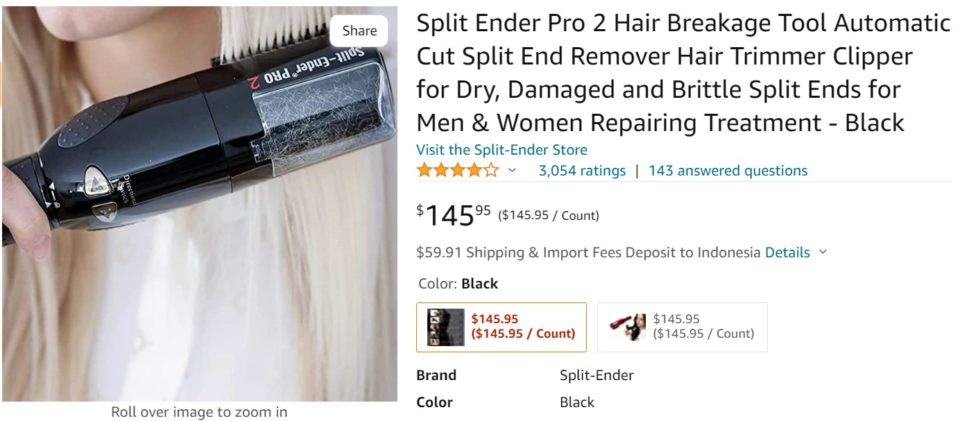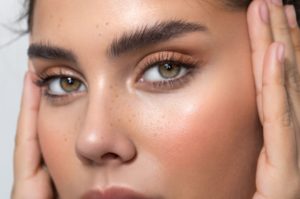It is awesome to have gorgeous hairstyle and cool haircut, but what’s even more matter is to have healthy hair. One of the most common problems that won’t let you have a healthy hair is none other than split ends. It is a persistent issue that may happen to all hair with different textures, lengths, and color, so you probably have had to deal with them at some points. However, have you ever wondered how split ends under microscope look like?
Split end is a common term used for hair shaft that being split or frayed. It happens when the outermost hair layer, called cuticle, resulting in exposed hair cortex. While it is more common to be found in longer hair, everyone is actually susceptible of it. Another typical misconception about split end is that it only affects the ends of the hair because despite the name, your hair may split anywhere throughout its shaft. Then it results in damaged hair that becomes difficult to style and manage due to dullness and roughness.
You are able easily detect split ends by feeling the texture of your hair. If it turns brittle, dry, and frayed then there is a possibility that the problem exists. It may due to exposure to hair styling tools that use heat such as hair straightening, blow dying, or hair curling, but it’s also probably caused by exposure to extreme sunlight and weather or the use of harmful chemical ingredients on your hair products. There are a lot of possible causes of split ends which will be discussed further below.
If you are curious as of how split ends under microscope appear to be, what cause them, how to detect them as early as possible, and how to treat or prevent them from happening then continue read the following article.
How Split Ends under Microscope Look Like
Visually through bare eyes, it is actually quite easy to spot split ends. Just take a bit of your hair strand and examine it all the way through the end: is there a separate hair strands that stick out from each other like a V shape, possibly at the bottom of its shaft? Is there a hair strand that looks lighter in terms of color compared to the rest of your hair? If the answers to these physical characteristics are yes, then it’s almost certain that your hair has been damaged either from environmental causes, heat styling factors, or chemicals.
Your hair is rooted on the follicles beneath your scalp. The hair itself is actually comprised of two major parts. First is the part within follicle beneath the skin, which is typically called the rood, and second is the part that sticks out the scalp surface, which normally referred as shaft. Fun fact, hair shaft is actually already dead but the root part is still alive so it won’t easily decay. That’s why human DNA can be found only on the root parts.
So how exactly split ends under microscope examination look like? If you use microscope with relatively low power, you may see hair on the scalp with flat scales on the outer layer from the root to the end part that points towards outside part. These flat scales are named cuticle, which comprised on the similar keratin protein that also found on your toenails, fingernails, and skin.
The primary job of cuticle that exists on your hair shaft is to provide protection to cortex, the inner layer with softer substance. Your hair growth actually happens on the cuticle, but when it is being abused by the use of harsh chemical or exposed to other damaging factor, the flat scales are impaired and the cuticles become harmed. If the damage is severe enough, you might be able to see cortex part under microscope.
What Cause Split Ends
Healthy hair is the dream hair for a lot of people, but when damage comes, it seems to be impossible to achieve. If you are struggling with split ends or hair breakage nowadays, know that other millions are struggling with you. Now that you know split ends under microscope, it’s time to learn what cause it.
Here is the list of split end possible causes:
- Chemical treatments
This includes hair straightening, perming, and hair coloring. These processes pose a risk of breaking down the structure of your hair that not only results in brittle look, but also weakened composition. This may lead to more problems beyond split ends. When your hair becomes overly dry, its tip may fray out and it will spread to the hair strand. It results in unwanted appearance of messy hair because the hair strands are sticking out to various directions.
- Heat hair styling tools
The heat from your hairstyling tools can weaken your hair in dramatic way. The effect is even more prominent if you are not using heat protection every time your hair is exposed to high temperatures. Extreme heat lifts off moisture and puts the hair on strain, making it feels drier and become weaker by times. Even though a lot of people seem like using heat protectant will be a sufficient protection, in fact the formula is not enough to save your hair from heat-induced damage. It often only reduces the harm effect but your hair will continue to be damaged.
- Dehydration
Another possible of split ends is dehydration. Besides heat hairstyling tools, you may unintentionally damage your own hair by using harsh products that contain drying ingredients such as SLS or non-fatty alcohols. These may make your hair feels brittle and dry, then ultimately results in breakage-prone hair shaft.
How to Know if You Have Split Ends
After looking at split ends under microscope, you are able to get better anatomy understanding and decide if the hair is healthy or not. However, the symptoms and signs of split ends may be detected in simpler way to.
Exploring the symptoms and signs of damaged hair might be worth it so you can maintain it to be healthy, bouncy, and voluminous. Here are several signs to watch out before it’s getting too late:
- Tangled hair
Have you ever cut your hair and realize afterwards, of how soft it becomes to the point that your fingers glide through the strands easily? Then by time, you notice that your fingers often stuck when it runs at the tips of your hair. You feel like your hair are twisted and knotted more often than not, and it keeps tangled itself even after being detangled.
- Visible split ends
Yes, the easiest way to detect split ends is to just examine the hair tips and fibers. Your hair shaft may open up at the end into V or Y shape, and these separated tips seem to be thinner than your other hair strands.
- Easily broken hair
Notice if you have more hair falls when you’re washing your hair. Inspect if they look thinner than the usual thickness of your hair.
- Dry tips
Damaged hair will lose shine and delicacy. Due to the stripped outer layer that supposed to be protective, it is unable to maintain moisture which leads to coarse and dry tips.
- Slow growth
As mentioned in prior, the danger of split ends is because it may move further up the hair strand instead of just remain at the hair tip. If you notice that your hair grows at really slow pace, the shafts might be breaking all this time.
Prevention and Treatment for Split Ends
It is truly an unfortunate fact that split ends cannot be treated or healed. The only way to eliminate this certain problem is by cutting the affected area. That’s why you have to perform prevention as soon as possible. Read these three tips below to help you prevent the issue:
- Wash your hair gently
Hair in wet condition is even more vulnerable to damage than dry hair. You may create breakage by heavy and frequent rubbing, due to harmed hair cuticles. You need to rub the hair gently by patting it to the towel and avoid damage or breakage.
- Prioritize hydration
Dryness is the number one cause of weakened and damaged hair. Consider using hair mask regularly to give back moisture to your hair. Hair mask is an intensive treatment in the form of deep conditioning to hydrate, moisturize, and reduce frizzy hair to bring back shinier and softer hair strands.
- Minimize the heat
Hairstyling appliances that involve heat shouldn’t be used on everyday basis, because they may change the protein structure of your hair. If it’s really necessary to use heat tools then prefer the lowest temperature setting and use heat protectant beforehand.
You have better understanding of how split ends under microscope and general knowledge about them now, so you can prevent them before things get massive and the damage become too severe. By using the preventive tips above, you’d be able to feel less worry about repairing your hair and be more confident about showing your healthy hair off.







